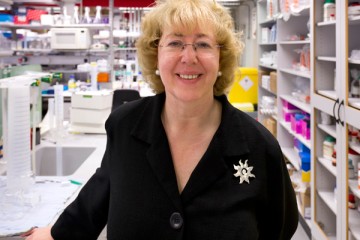Embryonic stem cell-derived cardiomyocytes as a model system for cardiac investigations

At a glance
Co-investigator(s)
- Dr Nadire Ali
R
- Replacement
Contents
Overview
Project background
The incidence of heart failure is increasing due to an ageing population and success in treating heart attacks. Patients with damage to the myocardium after a heart attack are at high risk for progressive heart failure. Animal models can be used to investigate heart attacks and progressive heart failure, and have contributed to the advances in both drug treatments and devices. Currently, primary isolated cardiac myocytes can be isolated from animal hearts, however these have a number of limitations predominantly due to the limited plasticity of the heart. Isolated cardiac myocytes do not divide and undergo rapid de-differentiation limiting the useful culture period to one to two days.
Why we funded it
This Project Grant aims to assess the potential of embryonic stem cell (ESC)-derived cardiac cells to replace the need for primary isolated cardiac myocytes from rats, rabbits or guinea pigs.
The isolation of cardiac myocytes requires removal of the heart, which is then enzymatically digested to isolate the cells. The animal is not subject to any procedures prior to cell isolation. Replacing the primary cardiac myocytes with cells derived from ESCs has the potential to replace up to 180 animals annually in Professor Harding’s group. Approximately 1,200 papers were published in 2005 using the isolated cardiac myocyte preparation requiring between 10 and 50 animals per publication, providing further scope for replacement internationally.
Research methods
Embryoid bodies formed from aggregated ESCs, derived from mice or humans, will be used to generated ESC-derived myocytes (ESCMs). Embryoid bodies are initiated in hanging drops and sustained in differentiation media before single cardiomyocytes can be isolated. The spontaneous appearance of beating cardiac myocytes occurs in cells derived from both species, and can beat for up to 70 days in culture as the cells mature. The newly derived ESCMs will be characterised to assess the basic physiological characteristics of the cell including morphology, electrophysiology and intracellular signalling. These characteristics will then be compared to primary adult cardiac myocytes. After characterisation, the contractile response of the ESCMs to selected neurohormonal agents currently being investigated for their roles in heart failure will be analysed.
Application abstract
Because of the huge impact of heart disease on human health, a large number of animal studies are performed for the investigation of disease hypotheses, drug discovery and toxicology testing. One of the reasons for the predominance of in vivo work in this area is the difficulty associated with finding a suitable in vitro model. Human tissue is difficult to obtain, and there are scientific and ethical problems associated with its use. Primary animal cardiac myocytes have been a successful preparation because of the preservation of their structure and function after isolation, and a great deal of work has been done in our laboratory to validate the use of primary animal (and human) myocytes as a model for in vivo cardiac responses. However, they have insurmountable limitations in terms of survival in culture (1-2 days), and meaningful transfection is only possible using viral vectors. Embryonic stem cells have the potential to produce myocytes representing all phenotypes in the heart (atrial, nodal and ventricular). Since they may be obtained from human sources, they may act as a more relevant preparation than animal tissue. They can continue to beat regularly in culture for 70 days (the longest time tested) and can be transfected using plasmid DNA. They may also be created from mutant ES lines, raising the potential for creation of transgenic myocytes without the mouse. Large banks of these mutant ES lines exist, and are available for purchase. In the present project we aim to validate the ES cell derived cardiac myocyte (ESCM) by comparison with adult myocytes for both human and mouse lines. Contractile responses to a bank of agents under investigation for their roles in heart failure (neurohormones, cytokines etc) will be determined, and subtypes of receptors mediating responses will be investigated using specific antagonists. Comparisons will be made to responses of normal adult human or mouse myocytes, either from past experiments or studies done in parallel. Myocytes will also be generated from a mouse mutant ES line lack inhibitory G-protein to test hypotheses related to beta1- and beta2-adrenoceptor coupling. Human and mouse ESCM are established in our laboratory and we have developed methods for measuring their contraction. For basic cardiac investigations the ESCM preparation has the potential to replace approximately 180 animals per year in my own laboratory and 1,500 studies per year worldwide. The long-term potential in terms of pharmaceutical drug discovery is much larger.
Impacts
Publications
- Földes G et al. (2014). Immunosuppressive agents modulate function, growth, and survival of cardiomyocytes and endothelial cells derived from human embryonic stem cells. Stem Cells Dev. 23(5):467-76. doi: 10.1089/scd.2013.0229
- Mioulane M et al. (2012). Development of high content imaging methods for cell death detection in human pluripotent stem cell-derived cardiomyocytes. Journal of cardiovascular translational research 5:593-604. doi: 10.1007/s12265-012-9396-1
- Földes G et al. (2011). Modulation of human embryonic stem cell-derived cardiomyocyte growth: a testbed for studying human cardiac hypertrophy? Journal of molecular and cellular cardiology 50:367-76. doi:10.1016/j.yjmcc.2010.10.029
- Földes G et al. (2010). Innate immunity in human embryonic stem cells: comparison with adult human endothelial cells. PLoS ONE 5(5):e10501. doi: 10.1371/journal.pone.0010501
- Abdul Kadir SH et al. (2009). Embryonic stem cell-derived cardiomyocytes as a model to study fetal arrhythmia related to maternal disease. Journal of Cellular and Molecular Medicine 13(9b):3730-3741. doi: 10.1111/j.1582-4934.2009.00741.x
- Brito-Martins M et al. (2008). Beta (1)- and beta (2) adrenoreceptor responses in cardiomyocytes derived from human embryonic stem cells: comparison with failing and non-failing adult human heart. British Journal of Pharmacology 153:751-759. doi: 10.1038/sj.bjp.0707619
- Jawad H et al. (2008). Myocardial tissue engineering. British medical bulletin 87(1):31-47. doi: 10.1093/bmb/ldn026
- Harding SE et al. (2007). The human embryonic stem cell-derived cardiomyocyte as a pharmacological model. Pharmacology & Therapeutics 113:341-353. doi: 10.1016/j.pharmthera.2006.08.008
